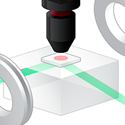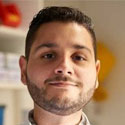Hot Off the Press – January 26, 2023 Summary We recently introduced a rat model of incubation (time-dependent increase) of oxycodone craving after voluntary abstinence induced by negative consequences of drug seeking. Here, we used the activity marker Fos, muscimol-baclofen (GABAa+GABAb receptor agonists) global inactivation, and Daun02 selective inactivation of putative relapse-associated neuronal ensembles, to… [Read More]
News Main
Illuminating the monoamine transporters: Fluorescently labelled ligands to study dopamine, serotonin and norepinephrine transporters
Reviews To Read – January 2023. Published in Basic & Clinical Pharmacology & Toxicology by Gisela Andrea Camacho-Hernandez , Khorshada Jahan, and Amy Hauck Newman of the NIDA IRP Medicinal Chemistry Section. The monoamine transporters are proteins that are primarily responsible for the clearance of dopamine, serotonin and norepinephrine, important monoamine neurotransmitters that are involved… [Read More]
Technology Development Initiative – Paper of the Month – January 2023
Rapid Quantum Magnetic IL-6 Point-of-Care Assay in Patients Hospitalized with COVID-19. Diagnostics.
The quantum diamond microscope system is a sensitive method to detect target proteins in a short time compared to similar immunocomplex-based detection methods (e.g. traditional ELISAs). This method does not require removal of unbound beads or extensive wash steps thus providing relatively fast and sensitive assay for measuring protein targets in pre-clinical and clinical applications. [Read More]
A red nucleus-VTA glutamate pathway underlies exercise reward and the therapeutic effect of exercise on cocaine use
Featured Paper of the Month – January 2023
Published in Science Advances by Yi He and Zheng-Xiong Xi, et al. of the NIDA IRP Addiction Biology Unit.
It is well known that physical exercise is rewarding and protective against drug abuse and addiction. However, the neural mechanisms underlying these actions are not fully understood. In this report, we found that prolonged daily voluntary wheel-running produced a more robust increase in c-fos expression in the red nucleus (RN) than in other brain regions. Subsequent neuronal tracing imaging and electrophysiological assays demonstrated that most RN neurons are glutamatergic in its magnocellular portion (RNm) and wheel-running activates a subset of RNm glutamate neurons that project to the neighboring ventral tegmental area (VTA), particularly to contralateral VTA dopamine neurons…
Calcium activity is a degraded estimate of spikes
Hot Off the Press – December 22, 2022 Summary Neurons communicate via electrical signals – spikes – and recording these has provided fundamental information regarding how the brain works. When neurons send electrical signals, several other biological signals occur, notably calcium. Calcium signaling is often used to make inferences about spike activity. However, it was… [Read More]
Kauê Costa named an Allen Institute Next Generation Leader
The Allen Institute has announced six new Next Generation Leaders (NGL), members of a unique neuroscience advisory panel made up of early-career researchers who will help advise research efforts at the Allen Institute for Brain Science, the MindScope Program, and the Allen Institute for Neural Dynamics. Among the new panel members is Kauê Machado Costa,… [Read More]
Technology Development Initiative – Paper of the Month – December 2022
Nanoparticle single-cell multiomic readouts reveal that cell heterogeneity influences lipid nanoparticle-mediated messenger RNA delivery. Nature Nanotechnology.
Researchers from the Georgia Institute of Technology and Emory University’s School of Medicine have developed a system that makes nanoparticle delivery to subsets of cells more predictable by combining DNA barcoding with a nanoparticle delivery system called single-cell nanoparticle targeting-sequencing (SENT-seq). Using SENT-seq, the investigators identified how different nanoparticles deliver DNA barcodes and mRNA into cells to affect the transcriptome and proteome with single cell resolution. [Read More]
Muscarinic Acetylcholine M2 Receptors Regulate Lateral Habenula Neuron Activity and Control Cocaine Seeking Behavior
Featured Paper of the Month – December 2022
Published in The Journal of Neuroscience by Clara Wolfe and Carl Lupica et al. of the NIDA IRP Electrophysiology Research Section.
The lateral habenula (LHb) is a brain region receiving information from brain areas involved in decision making, with influence on motivation, reward, and movement. This interface between thoughts, emotions, and actions is how the LHb permits adaptive behavior, and LHb dysfunction is implicated in psychiatric and drug use disorders. Silencing the LHb impairs control over cocaine seeking in rats and muscarinic acetylcholine receptors (mAChR) are also implicated…
Incubation of palatable food craving is associated with brain-wide neuronal activation in mice
Hot Off the Press – November 21, 2022 Summary Relapse to reward seeking progressively increases during abstinence, a behavioral phenomenon termed incubation of craving. Mechanistic studies of incubation can lead to novel relapse treatments. However, previous studies have primarily used rat models and targeted region-by-region analyses, and a brain-wide functional atlas of incubation of reward… [Read More]
Yavin Shaham Wins the 2022 Ruth L. Kirschstein Mentoring Award
Yavin Shaham, Ph.D., Chief of Behavioral Neuroscience Research Branch and Neurobiology of Relapse Section has been awarded the 2022 Ruth L. Kirschstein mentoring award by the National Institutes of Health (NIH) as part of the 2022 NIH Director’s Awards. The NIH Director’s Awards recognizes exceptional performance and special efforts beyond regular job assignments. The Ruth… [Read More]










